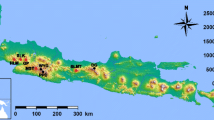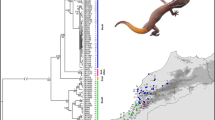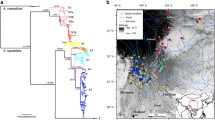Abstract
An important goal of evolutionary and conservation biology is the identification of units below the species level, such as Evolutionarily Significant Units (ESUs), providing objectively delimited units for species conservation and management. In this study we tested the hypothesis that Cuvier’s dwarf caiman (Paleosuchus palpebrosus)—a species broadly distributed across several biomes and watersheds of South America—is comprised of different ESUs. We analyzed mitochondrial cytochrome b sequences of 206 individuals and 532 unlinked ddRAD loci of 20 individuals chosen from amongst the mitochondrial haplogroups. Analysis of the cytochrome b sequences revealed four mitochondrial clusters, while STRUCTURE analysis of ddRAD loci detected three genomic clusters with different levels of mixture between them. Using the Adaptive Evolutionary Conservation (AEC) framework we identified three ESUs: “Amazon”, “Madeira-Bolivia” and “Pantanal”; one of them composed of two different Management Units (MUs), “Madeira” and “Bolivia”. In general, based on the comparisons with other crocodilian species, genetic diversity of each lineage was moderate however, the Madeira MU showed fivefold lower genetic diversity than other geographic groups. Considering the particularities of each Paleosuchus palpebrosus conservation unit, we recommend that the conservation status of each is evaluated separately. Tropical biodiversity is largely underestimated and in this context the broadly distributed species are the most likely candidates to harbor distinct evolutionary lineages. Thus, we suggest that conservation research should not neglect species that are generally considered of Least Concern by IUCN due to the taxon’s broad geographic distribution.



Similar content being viewed by others
References
Avise JC (1994) Molecular markers, natural history, and evolution. Chapman & Hall, New York
Beerli P (2006) Comparison of Bayesian and maximum-likelihood inference of population genetic parameters. Bioinformatics 22:341–345. https://doi.org/10.1093/bioinformatics/bti803
Brown DM, Brenneman RA, Koepfli KP, Pollinger JP, Milá B, Georgiadis NJ et al (2007) Extensive population genetic structure in the giraffe. BMC Biol 5:57. https://doi.org/10.1186/1741-7007-5-57
Campos Z, Magnusson WE (2016) Density and Biomass Estimates by Removal for an Amazonian Crocodilian, Paleosuchus palpebrosus. PLoS ONE. https://doi.org/10.1371/journal.pone.0156406
Campos Z, Mourão G (2006) Conservation status of the dwarf caiman, Paleosuchus palpebrosus, in the region surrounding Pantanal. Crocodile Spec Group Newsl 25:9–10
Campos Z, Coutinho M, Abercrombie C (1995) Size structure and sex ratio of dwarf caiman in the Serra Amolar, Pantanal, Brazil. Herpetol J 5:321–322
Campos Z, Sanaiotti T, Magnusson W (2010) Maximum size of dwarf caiman, Paleosuchus palpebrosus (Cuvier, 1807), in the Amazon and habitats surrounding the Pantanal, Brazil. Amphibia-Reptilia 31:439–442. https://doi.org/10.1163/156853810791769392
Campos Z, Marioni B, Farias IP, Verdade LM, Bassetti L, Coutinho ME et al (2013) Avaliação do risco de extinçao do jacaré-paguá Paleosuchus palpebrosus (Cuvier, 1807) no Brasil. Biodiversidade Brasileira 3:40–47
Campos Z, Sanaiotti T, Marques V, Magnusson WE (2015a) Geographic Variation in Clutch Size and Reproductive Season of the Dwarf Caiman, Paleosuchus palpebrosus, in Brazil. J Herpetol 49:95–98. https://doi.org/10.1670/11-224
Campos Z, Muniz FL, Farias IP, Hrbek T (2015b) Conservation status of the dwarf caiman Paleosuchus palpebrosus in the region of the Araguaia-Tocantins basin, Brazil. Crocodile Spec Group Newsl 34:4–8
Cella-Ribeiro A, Torrente-Vilara G, Hungria DB, Oliveira M (2013) As corredeiras do Rio Madeira. In: Queiroz LJ, Torrente-Vilara G, Ohara WM, Pires T, Zuanon J, Doria CRC (eds) Peixes do Rio Madeira, 1st edn. Dialeto Latin American Documentary, São Paulo, pp 56–63
Corander J, Marttinen P, Sirén J, Tang J (2008) Enhanced Bayesian modelling in BAPS software for learning genetic structures of populations. BMC Bioinformatics 9:539. https://doi.org/10.1186/1471-2105-9-539
Coyne KJ, Burkholder JM, Feldman RA, Hutchins DA, Cary SC (2004) Modified serial analysis of gene expression method for construction of gene expression profiles of microbial eukaryotic species. Appl Environ Microbiol 70:5298–5304. https://doi.org/10.1128/AEM.70.9.5298
Crandall KA, Bininda-Emonds ORP, Mace GM, Wayne RK (2000) Considering evolutionary processes in conservation biology. Trends Ecol Evol 15:290–295. https://doi.org/10.1016/S0169-5347(00)01876-0
Cunningham SW, Shirley MH, Hekkala ER (2016) Fine scale patterns of genetic partitioning in the rediscovered African crocodile, Crocodylus suchus (Saint-Hilaire 1807). PeerJ. https://doi.org/10.7717/peerj.1901
Darriba D, Taboada GL, Doallo R, Posada D (2012) jModelTest 2: more models, new heuristics and parallel computing. Nat Methods 9:772. https://doi.org/10.1038/nmeth.2109
de Queiroz K (2007) Species concepts and species delimitation. Syst Biol 56:879–886. https://doi.org/10.1080/10635150701701083
Earl DA, VonHoldt BM (2012) STRUCTURE HARVESTER: a website and program for visualizing STRUCTURE output and implementing the Evanno method. Conserv Genet Resour 4:359–361. https://doi.org/10.1007/s12686-011-9548-7
Eaton DAR (2014) PyRAD: assembly of de novo RADseq loci for phylogenetic analysis. Bioinformatics 30:1844–1849. https://doi.org/10.1093/bioinformatics/btu121
Eaton MJ, Martin A, Thorbjarnarson J, Amato G (2009) Species-level diversification of African dwarf crocodiles (Genus Osteolaemus): a geographic and phylogenetic perspective. Mol Phylogenet Evol 50:496–506. https://doi.org/10.1016/j.ympev.2008.11.009
Edgar RC (2004) MUSCLE: multiple sequence alignment with high accuracy and high throughput. Nucleic Acids Res 32:1792–1797. https://doi.org/10.1093/nar/gkh340
Evanno G, Regnaut S, Goudet J (2005) Detecting the number of clusters of individuals using the software structure: a simulation study. Mol Ecol 14:2611–2620. https://doi.org/10.1111/j.1365-294X.2005.02553.x
Excoffier L, Lischer HEL (2010) Arlequin suite ver 3.5: a new series of programs to perform population genetics analyses under Linux and Windows. Mol Ecol Resour 10:564–567
Farias IP, Silveira R, Thoisy B, Monjeló LA, Thorbjarnarson J, Hrbek T (2004) Genetic diversity and population structure of Amazonian crocodilians. Anim Conserv 7:265–272. https://doi.org/10.1017/S136794300400143X
Fennessy J, Bidon T, Reuss F, Kumar V, Elkan P, Nilsson MA et al (2016) Multi-locus analyses reveal four giraffe species instead of one. Curr Biol 26:2543–2549. https://doi.org/10.1016/j.cub.2016.07.036
Franke FA, Schmidt F, Borgwardt C, Bernhard D, Bleidorn C, Engelmann WE, Schlegel M (2013) Genetic differentiation of the African dwarf crocodile Osteolaemus tetraspis Cope, 1861 (Crocodylia: Crocodylidae) and consequences for European zoos. Org Divers Evol 13:255–266. https://doi.org/10.1007/s13127-012-0107-1
Frankham R, Ballou JD, Briscoe DA (2004) A primer of conservation genetics. Cambridge University Press, New York
Fraser DJ, Bernatchez L (2001) Adaptive evolutionary conservation: towards a unified concept for defining conservation units. Mol Ecol 10:2741–2752. https://doi.org/10.1046/j.1365-294X.2001.t01-1-01411.x
Fu YX (1997) Statistical tests of neutrality of mutations against population growth, hitchhiking and background selection. Genetics 147:915–925
Funk WC, McKay JK, Hohenlohe PA, Allendorf FW (2012) Harnessing genomics for delineating conservation units. Trends Ecol Evol 27:489–496. https://doi.org/10.1016/j.tree.2012.05.012
Godshalk R (2006) Phylogeography and conservation genetics of the yacare caiman (Caiman yacare) of South America. PhD thesis, University of Florida at Gainesville
Gravena W, Farias IP, Da Silva MNF, Da Silva VMF, Hrbek T (2014) Looking to the past and the future: Were the Madeira River rapids a geographical barrier to the boto (Cetacea: Iniidae)? Conserv Genet 15:619–629. https://doi.org/10.1007/s10592-014-0565-4
Gravena W, da Silva VMF, da Silva MNF, Farias IP, Hrbek T (2015) Living between rapids: genetic structure and hybridization in botos (Cetacea: Iniidae: Inia spp.) of the Madeira River, Brazil. Biol J Linn Soc 114:764–777. https://doi.org/10.1111/bij.12463
Green MR, Sambrook J (2012) Molecular cloning: a laboratory manual: three-volume set, 4th edn. Cold Spring Harbor Laboratory Press, New York
Guia APO, Saitoh T (2007) The gap between the concept and definitions in the evolutionarily significant unit: the need to integrate neutral genetic variation and adaptive variation. Ecol Res 22:604–612. https://doi.org/10.1007/s11284-006-0059-z
Hekkala ER, Amato G, DeSalle R, Blum MJ (2010) Molecular assessment of population differentiation and individual assignment potential of Nile crocodile (Crocodylus niloticus) populations. Conserv Genet 11:1435–1443. https://doi.org/10.1007/s10592-009-9970-5
Hekkala ER, Shirley MH, Amato G, Austin JD, Charter S, Thorbjarnarson J et al (2011) An ancient icon reveals new mysteries: mummy DNA resurrects a cryptic species within the Nile crocodile. Mol Ecol 20:4199–4215. https://doi.org/10.1111/j.1365-294X.2011.05245.x
Hrbek T, Vasconcelos WR, Rebêlo GH, Farias IP (2008) Phylogenetic relationships of south american alligatorids and the caiman of Madeira River. J Exp Zool A 309:588–599. https://doi.org/10.1002/jez.430
Hrbek T, Silva VMF, Dutra N, Gravena W, Martin AR, Farias IP (2014) A new species of river dolphin from Brazil or: how little do we know our biodiversity. PLoS ONE 9:e0083623. https://doi.org/10.1371/journal.pone.0083623
Hubert N, Renno JF (2006) Historical biogeography of South American freshwater fishes. J Biogeogr 33:1414–1436. https://doi.org/10.1111/j.1365-2699.2006.01518.x
Hubert N, Duponchelle F, Nuñes J, Garcia-Davila C, Paugy D, Renno JF (2007) Phylogeography of the piranha genera Serrasalmus and Pygocentrus: implications for the diversification of the Neotropical ichthyofauna. Mol Ecol 16:2115–2136. https://doi.org/10.1111/j.1365-294X.2007.03267.x
IUCN (2016) The IUCN red list of threatened species. Version 2016.3. http://www.iucnredlist.org. Accessed 20 Dec 2016
Jackson JA, Steel DJ, Beerli P, Congdon BC, Olavarría C, Leslie MS et al (2014) Global diversity and oceanic divergence of humpback whales (Megaptera novaeangliae). Proc R Soc B 281:20133222. https://doi.org/10.1098/rspb.2013.3222
Jakobsson M, Rosenberg NA (2007) CLUMPP: a cluster matching and permutation program for dealing with label switching and multimodality in analysis of population structure. Bioinformatics 23:1801–1806. https://doi.org/10.1093/bioinformatics/btm233
Kenny EM, Cormican P, Gilks WP, Gates AS, O’Dushlaine CT et al (2011) Multiplex target enrichment using DNA indexing for ultra-high throughput SNP detection. DNA Res 18:31–38. https://doi.org/10.1093/dnares/dsq029
Li H, Handsaker B, Wysoker A, Fennell T, Ruan J, Homer N, Marth G, Abecasis G, Durbin R, 1000 Genome Project Data Processing Subgroup (2009) The Sequence alignment/map (SAM) format and SAMtools. Bioinformatics 25:2078–2079. https://doi.org/10.1093/bioinformatics/btp352
Magnusson WE (1992) Paleosuchus palpebrosus. Cat Am Amphib Rept 554:1–554.2
Magnusson WE, Campos Z (2010) Cuvier’s smooth-fronted caiman Paleosuchus palpebrosus. In: Manolis SC, Stevenson C (eds) Crocodiles: status survey and conservation action plan, 3rd edn. Crocodile Specialist Group, Darwin, pp 40–42
Milián-García Y, Castellanos-Labarcena J, Russello MA, Amato G (2018) Mitogenomic investigation reveals a cryptic lineage of Crocodylus in Cuba. Bull Mar Sci. https://doi.org/10.5343/bms.2016.1134
Moritz C (1994) Defining “evolutionarily significant units” for conservation. Trends Ecol Evol 9:373–375. https://doi.org/10.1016/0169-5347(94)90057-4
Moritz C, Lavery S, Slade R (1995) Using allele frequency and phylogeny to define units for conservation and management. In: Nielsen JL, Powers GA (eds) Evolution and the aquatic ecosystem: defining unique units in population conservation, symposium. American Fisheries Society, Maryland, pp 249–262
Nater A, Mattle-Greminger MP, Nurcahyo A, Nowak MG, Manuel M de, Desai T et al (2017) Morphometric, behavioral, and genomic evidence for a new Orangutan species. Curr Biol 27:3487–3498. https://doi.org/10.1016/j.cub.2017.09.047
Nei M (1987) Molecular evolutionary genetics. Columbia University Press, New York
Padial JM, Miralles A, De la Riva I, Vences M (2010) The integrative future of taxonomy. Front Zool 7:16. https://doi.org/10.1186/1742-9994-7-16
Peterson BK, Weber JN, Kay EH, Fisher HS, Hoekstra HE (2012) Double digest RADseq: an inexpensive method for de novo SNP discovery and genotyping in model and non-model species. PLoS ONE 7:e37135. https://doi.org/10.1371/journal.pone.0037135
Pickles RSA, Groombridge JJ, Zambrana VDR, Van Damme P, Gottelli D, Kundu S (2011) Evolutionary history and identification of conservation units in the giant otter, Pteronura brasiliensis. Mol Phylogenet Evol 61:616–627. https://doi.org/10.1016/j.ympev.2011.08.017
Pritchard JK, Stephens M, Donnelly P (2000) Inference of population structure using multilocus genotype data. Genetics 155:945–959. https://doi.org/10.1111/j.1471-8286.2007.01758.x
Rambaut A (2014) Figtree 1.4. 2 software. http://tree.bio.ed.ac.uk/software/figtree
Roe KJ, Lydeard C (1998) Species delineation and the identification of evolutionarily significant units: lessons from the freshwater mussel genus Potamilus (Bivalvia: Unionidae). J Shellfish Res 17:1359–1363
Rognes T, Flouri T, Nichols B, Quince C, Mahé F (2016) VSEARCH: a versatile open source tool for metagenomics. PeerJ 4:e2584. https://doi.org/10.7717/peerj.2584
Rohland N, Reich D, Mallick S, Meyer M, Green RE, Georgiadis NJ et al (2010) Genomic DNA Sequences from mastodon and woolly mammoth reveal deep speciation of forest and savanna elephants. PLoS Biol 8:e1000564. https://doi.org/10.1371/journal.pbio.1000564
Ronquist F, Teslenko M, van der Mark P, Ayres DL, Darling A, Hohna S et al (2012) MrBayes 3.2: efficient bayesian phylogenetic inference and model choice across a large model space. Syst Biol 61:539–554. https://doi.org/10.1093/sysbio/sys029
Rosenberg NA (2004) DISTRUCT: a program for the graphical display of population structure. Mol Ecol Notes 4:137–138. https://doi.org/10.1046/j.1471-8286.2003.00566.x
Ryder OA (1986) Species conservation and systematics: the dilemma of subspecies. Trends Ecol Evol 1:9–10. https://doi.org/10.1016/0169-5347(86)90059-5
Salzburger W, Ewing GB, Von Haeseler A (2011) The performance of phylogenetic algorithms in estimating haplotype genealogies with migration. Mol Ecol 20:1952–1963. https://doi.org/10.1111/j.1365-294X.2011.05066.x
Scheffers BR, Joppa LN, Pimm SL, Laurance WF (2012) What we know and don’t know about Earth’s missing biodiversity. Trends Ecol Evol 27:501–510. https://doi.org/10.1016/j.tree.2012.05.008
Shirley MH, Vliet KA, Carr AN, Austin JD (2014a) Rigorous approaches to species delimitation have significant implications for African crocodilian systematics and conservation. Proc R Soc B 281:20132483. https://doi.org/10.1098/rspb.2013.2483
Shirley MH, Villanova VL, Vliet KA, Austin JD (2014b) Genetic barcoding facilitates captive and wild management of three cryptic African crocodile species complexes. Anim Conserv 18:322–330. https://doi.org/10.1111/acv.12176
Streicher JW, Schulte IIJA., Wiens JJ (2016) How should genes and taxa be sampled for phylogenomic analyses with missing data? An empirical study in iguanian lizards. Syst Biol 65:128–145. https://doi.org/10.1093/sysbio/syv058
Tajima F (1989) Statistical method for testing the neutral mutation hypothesis by DNA polymorphism. Genetics 123:585–595
Vasconcelos WR, Hrbek T, Da Silveira R, De Thoisy B, Marioni B, Farias IP (2006) Population genetic analysis of Caiman crocodilus (Linnaeus, 1758) from South America. Genet Mol Biol 29:220–230. https://doi.org/10.1590/S1415-47572006000200006
Vasconcelos WR, Hrbek T, Da Silveira R, De Thoisy B, Ruffeil LAAS., Farias IP (2008) Phylogeographic and Conservation Genetic Analysis of the Black Caiman (Melanosuchus niger). J Exp Zool A 309A:600–613. https://doi.org/10.1002/jez.452
Venegas-Anaya M, Crawford AJ, Galván AHE, Sanjur OI, Densmore LD III, Bermingham E (2008) Mitochondrial DNA phylogeography of Caiman crocodilus in Mesoamerica and South America. J Exp Zool 309A:614–627. https://doi.org/10.1002/jez.502
Vogler AP, Desalle ROB (1994) Diagnosing units of conservation management. Conserv Biol 8:354–363. https://doi.org/10.1046/j.1523-1739.1994.08020354.x
Waples RS (1991) Pacific salmon, Oncorynchus spp. & the definition of “species” under the endangered species act. Mar Fish Rev 53:11–22
Waples RS (1995) Evolutionarily significant units and the conservation of biological diversity under the endangered species act. In: Nielsen JL, Powers GA (eds) Evolution and the aquatic ecosystem: defining unique units in population conservation, vol 17. American Fisheries Society, Maryland, pp 8–27
Zwickl DJ (2006) Genetic algorithm approaches for the phylogenetic analysis of large biological sequence datasets under the maximum likelihood criterion. Dissertation, The University of Texas, Austin
Acknowledgements
This study would have been impossible without the people who helped with the field collections: Daniel Martins, Dênis Tilcara, Deyla Oliveira, José Augusto da Silva, Manoel Rodrigues, Pedro Almeida, Tânia Sanaiotti, Valéria Machado and William Vasconcelos; or without Guto Ruffeil who deposited samples in the CTGA/UFAM tissue collection. We are also thankful to Mitchell Eaton for additional information about Osteolaemus species. This project was approved by Embrapa ethics committee under the Permit no. 009/2016 and the caimans were captured under License no. 13048-1 granted by the Brazilian Institute of Environment and Renewable Natural Resources (IBAMA). In French Guiana, the species is not protected and sampling does not require license. This study was financed by the following Grants: CNPq/CT-Amazon Project no. 575603/2008-9 awarded to IPF, CNPq Project no. 482662/2013-1 to TH, and CNPq Project no. 470383/2007-0 and 479179/2014 to ZC. We are also grateful for the additional financial and logistical support from Embrapa Pantanal (Macroprogram 3), Instituto Nacional de Pesquisas da Amazônia (INPA), Fundect, O Boticário Foundation, Instituto Chico Mendes de Conservação da Biodiversidade (ICMBio) and Santo Antônio Energia. This work is part of FM’s thesis in the Genetics, Conservation and Evolutionary Biology program of INPA/UFAM. FM is supported by a Grant from FAPEAM, and IPF and TH by a Grant from CNPq.
Author information
Authors and Affiliations
Corresponding author
Electronic supplementary material
Below is the link to the electronic supplementary material.
Rights and permissions
About this article
Cite this article
Muniz, F.L., Campos, Z., Hernández Rangel, S.M. et al. Delimitation of evolutionary units in Cuvier’s dwarf caiman, Paleosuchus palpebrosus (Cuvier, 1807): insights from conservation of a broadly distributed species. Conserv Genet 19, 599–610 (2018). https://doi.org/10.1007/s10592-017-1035-6
Received:
Accepted:
Published:
Issue Date:
DOI: https://doi.org/10.1007/s10592-017-1035-6




